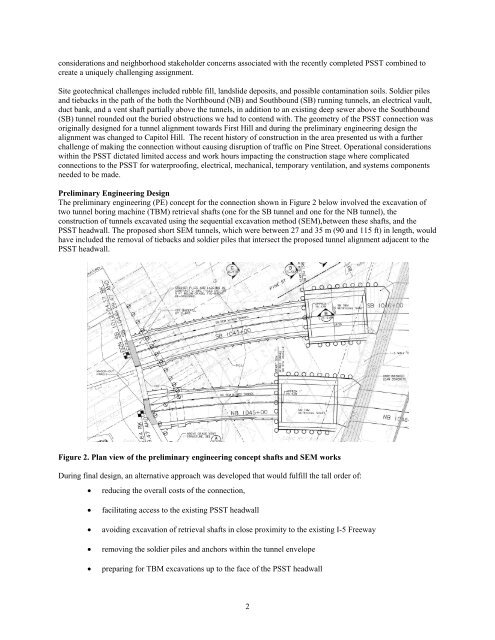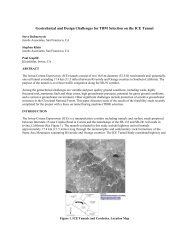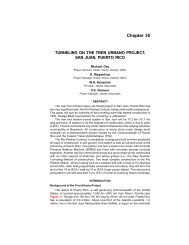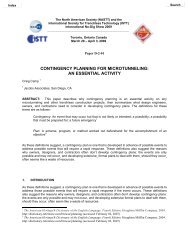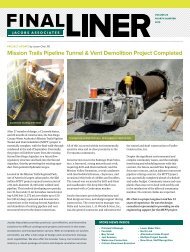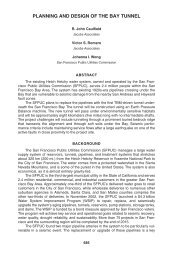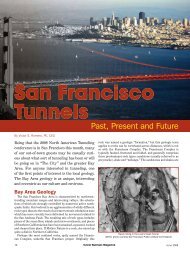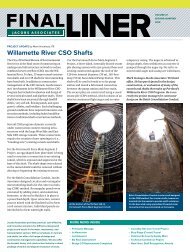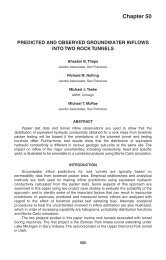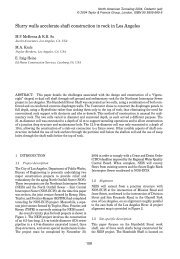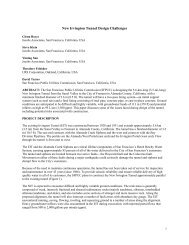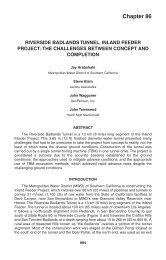Integration of Operations and Underground Construction: Sound ...
Integration of Operations and Underground Construction: Sound ...
Integration of Operations and Underground Construction: Sound ...
You also want an ePaper? Increase the reach of your titles
YUMPU automatically turns print PDFs into web optimized ePapers that Google loves.
considerations <strong>and</strong> neighborhood stakeholder concerns associated with the recently completed PSST combined to<br />
create a uniquely challenging assignment.<br />
Site geotechnical challenges included rubble fill, l<strong>and</strong>slide deposits, <strong>and</strong> possible contamination soils. Soldier piles<br />
<strong>and</strong> tiebacks in the path <strong>of</strong> the both the Northbound (NB) <strong>and</strong> Southbound (SB) running tunnels, an electrical vault,<br />
duct bank, <strong>and</strong> a vent shaft partially above the tunnels, in addition to an existing deep sewer above the Southbound<br />
(SB) tunnel rounded out the buried obstructions we had to contend with. The geometry <strong>of</strong> the PSST connection was<br />
originally designed for a tunnel alignment towards First Hill <strong>and</strong> during the preliminary engineering design the<br />
alignment was changed to Capitol Hill. The recent history <strong>of</strong> construction in the area presented us with a further<br />
challenge <strong>of</strong> making the connection without causing disruption <strong>of</strong> traffic on Pine Street. Operational considerations<br />
within the PSST dictated limited access <strong>and</strong> work hours impacting the construction stage where complicated<br />
connections to the PSST for waterpro<strong>of</strong>ing, electrical, mechanical, temporary ventilation, <strong>and</strong> systems components<br />
needed to be made.<br />
Preliminary Engineering Design<br />
The preliminary engineering (PE) concept for the connection shown in Figure 2 below involved the excavation <strong>of</strong><br />
two tunnel boring machine (TBM) retrieval shafts (one for the SB tunnel <strong>and</strong> one for the NB tunnel), the<br />
construction <strong>of</strong> tunnels excavated using the sequential excavation method (SEM),between these shafts, <strong>and</strong> the<br />
PSST headwall. The proposed short SEM tunnels, which were between 27 <strong>and</strong> 35 m (90 <strong>and</strong> 115 ft) in length, would<br />
have included the removal <strong>of</strong> tiebacks <strong>and</strong> soldier piles that intersect the proposed tunnel alignment adjacent to the<br />
PSST headwall.<br />
Figure 2. Plan view <strong>of</strong> the preliminary engineering concept shafts <strong>and</strong> SEM works<br />
During final design, an alternative approach was developed that would fulfill the tall order <strong>of</strong>:<br />
� reducing the overall costs <strong>of</strong> the connection,<br />
� facilitating access to the existing PSST headwall<br />
� avoiding excavation <strong>of</strong> retrieval shafts in close proximity to the existing I-5 Freeway<br />
� removing the soldier piles <strong>and</strong> anchors within the tunnel envelope<br />
� preparing for TBM excavations up to the face <strong>of</strong> the PSST headwall<br />
2


